November 2025:
11/5 – Sanderling
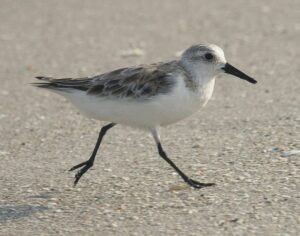
In my experience, it is common to see more than one Sanderling – usually there will be several to about twenty together in one area of the ocean’s edge. And they are often with other shorebirds like small sandpipers (Western and Least), Black-bellied Plovers, Ruddy Turnstones, Willets, Lesser Yellowlegs, Black Plovers, and Ruddy Turnstones. This video is about a minute and a half – if you watch it to the end, you will see this bird book it!!!!!
It would be my advice to you to turn your volume down or off – it was a windy day, and the sound of the wind will be loud. However, if you choose to leave your sound on, you will hear a human calling their dog at the end. Lots of walkers and dogs so shorebirds were scarce on this stretch of beach.
Video 9/25:
Raccoons1
Raccoons2
So this is why there is very little seed on the ground each morning! And the answer to the question – who is digging the holes? If you turn up your volume, you will hear night sounds – we live in a quiet neighborhood at night. You can go out any time after dark and just listen…… to insects, bullfrogs in July and August, owls in December and January, and right now you can even hear the leaves rustling in the breeze. It is a wonderful time to be outside, watch the stars, the moon, and just breathe. Let go ……..
Video 8/25: After the bath – Eastern Bluebird preening
Cleon shot this video out our kitchen window and it begins with an already wet male Eastern Bluebird preening on the tower that is in our garden. The other birds flitting around him are female and juvenile House Finches. Most songbirds molt in August-mid September and preening takes on a whole new significance for them as this process helps pull out older feathers and the birds make sure newer feathers are in their proper place, properly combed – or beaked!, and oiled. If you take a walk through your yard or favorite park – especially if there is water like a pond or small lake – you might see lots of feathers on the ground. Right now, walking through our backyard, there are Blue Jay feathers scattered throughout. Songbirds preen at least once every day all year round. But during a period of molting, they often preen several times a day and for much longer periods. This video is about 2 minutes long, but this bluebird made repeated trips to the birdbath for baths and then each time flew back to the tower for more preening. He bathed and preened for over 20 minutes. And just think – all this without a mirror or blow dryer!
Videos 8/25: More Ruby-throated Hummingbirds!
Ruby-throated Hummingbirds at another backyard feeder
Mary D. from Illinois sent me this video of her 2 hummingbird feeders. She does not have the woodland in her yard that Janelle C. has, but Mary has extensive flower gardens throughout her property and as you can see – a whole lot of hummingbirds! And it is simply mind-boggling how fast they move!
Ruby-throated Hummingbirds at Rock Springs Nature Center, Decatur IL.
I shot this video. Turn your sound up so you can hear them chattering at each other. These hummingbird feeders – and there are probably at least 4 more that are not shown – are all maintained by volunteers. They are checked, cleaned, and refilled every 2-3 days from April through September. A big job to take care of this many feeders, but these are dedicated volunteers. If you have a park or wildlife refuge near you that has a volunteer program, and your area is blessed with hummingbirds, check to see if they have a feeder program. if they have one, consider volunteering. If they do not, see if you can start one. All it takes is time and dedication. Feeders must be cleaned and refilled every 3-4 days – 3 is best. And if the temperatures are over 90, every 2 days. The hummingbirds will NOT show you any appreciation for all this time and care, but you will certainly be entertained with all their antics.
Video 8/25: Hummingbirds!
Janelle C. in Illinois sent me this video which she shot on 8/20. For the past week or so, she has had more Ruby-throated Hummingbirds at her feeders than she had all spring and summer. She and I both think she may have a few early migrators, but we also think she may have a few new juveniles who are from late second nests probably from somewhere in her yard. She has several acres which includes trees and part of a woodland – excellent hummingbird habitat. She told me the birds seem more playful than aggressive. Regardless of how old they are or where they spent their summer, they are all certainly keeping her entertained while she drinks her morning coffee!!!
If any of you have short videos of birds, and would like me to post them, please send them to me at lindahendricksspence@birdingbeyondthefieldguide.com
Video 8/25: You are not alone!
This proves that not all creatures are like me after dark – in their recliners, all curled up under a snuggie, and watching British mysteries! Some creatures are just as busy as bees all night long!
Video 8/25: Flocking up! Double-crested Cormorants and Ring-billed Gulls gathering….
Double-crested Cormorants and Ring-billed Gulls are flocking up and gathering on the silt dam at our near-by large man-made lake. The silt dam is just what its name says it is – a dam to prevent the spreading of silt. And in our case, the ‘silt’ is most often agricultural run-off which is a fancy way of saying that during downpours and storms, it is soil that is being washed away from the fields, through drainage ditches, and ends up being deposited into the lake. This is one of the reasons hedgerows between fields are so important. Drainage ditches are often in the middle of hedgerows, and the thick tangles of plants serve as wonderful natural sieves to help filter out soil from the rain water. However, here, as in all through the Midwest and on The Great Plains, many farmers have removed their hedgerows in order to farm every square inch of land, and so this filter system is no longer in place to the extent it once was.
If you have your sound turned up, you will hear the cries of the Ring-billed Gulls. And watch the cormorants. Some are sitting on the dam with their wings spread out – drying their feathers. Some are swimming in the lake and you will be able to see how low they sit in the water. Compare this to Mallards and Canada Geese who sit much higher in the water. You will also see a few cormorants take off. They are at some distance, but you will see they skim low across the water before rising into the air. They use their feet and legs to run across the surface of the water which helps them to get airborne. Once in the air, they are outstanding fliers. Cormorants are in migration right now and most of these that you see have arrived from up north. If you look at most range maps, you will see that central Illinois is a migration route. These cormorants on the dam will probably migrate to southern Illinois and then could end up anywhere in our southern states, in coastal Central America, or on the coasts of the islands in the Caribbean. The Ring-billed Gulls are the same. Most range maps show Illinois is part of their migration routes and they will winter in all our southern states, Central America, and on many of the islands in the Caribbean.
Video 8/25: American Goldfinch Foraging in our Front Garden
American Goldfinches nest late. Here in central Illinois, they start building nests in mid-late June. They hatch eggs generally in mid July to early August which is when all their favorite prairie and grassland flowers are either in full bloom or are seeding off – either way, these are great sources of food for their babies and juveniles. This male goldfinch is on the native prairie plant Rattlesnake Master (Eryngium yuccifolium).
Video 8/25: Downy Woodpecker Feeding Her Juvenile
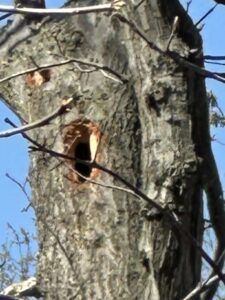 This is a short video of a female Downy Woodpecker feeding her juvenile who is just as big as she is. Popping those bits of peanuts right into its mouth! The photo to the left shows a tree in our back yard right at the shore of our small lake where this Downy was born. The parents excavated the hole this spring. As far as we know, they fledged three juveniles. Congratulations to the parents as raising juveniles is never easy and best of luck to all three as they begin their lives in our backyard.
This is a short video of a female Downy Woodpecker feeding her juvenile who is just as big as she is. Popping those bits of peanuts right into its mouth! The photo to the left shows a tree in our back yard right at the shore of our small lake where this Downy was born. The parents excavated the hole this spring. As far as we know, they fledged three juveniles. Congratulations to the parents as raising juveniles is never easy and best of luck to all three as they begin their lives in our backyard.
Video 7/25: Crop dusting!
Cleon shot this video this morning. We have about a week of crop dusting every year – we are in day 2. So if you are watching our livestreams and hear what sounds like we are under attack by a WWII plane – strafing our neighborhood – you can rest easy. All is well. At least from a war aspect.
If you have been following my blog for any length of time, you know our neighborhood is 4 miles from a small town in central Illinois and is surrounded by big chemical agriculture – corn and soybeans. Thousands and thousands of acres. Illinois is always one of the top 3 world-wide producers of corn and soybeans – right up there with Iowa. In the spring, you can watch farmers all around here pulling big tanks of chemicals which they apply to their fields with sprayers and big tractors. This time of year, they are spraying for insects and disease. I must admit, I am not all that troubled with Japanese beetles in my gardens – one of the target insects of these chemicals. The downside is we have very few butterflies and moths – right now just a few moths – no butterflies at all – nor have we had any since last fall. It has been the same for the 20 years we have lived here. We will have a few this late August and September – but only a few.
These chemicals take a toll on all insects – the devastating and the beneficial. And we all understand how wind carries sprays and if you need a reminder, turn on your sprinkler on a day with a breeze and watch the mist roll. My weather app says winds are at 10-15mph today. Looking out my window as I type this and watching the leaves on the trees, I would put it closer to 10mph. But that is still enough wind to blow the spray from these planes into the edges and beyond of the field they are spraying. Our house and garden sits in the middle of our neighborhood oasis and so we are at least a quarter of a mile from the nearest big field – this is the one being sprayed from the plane in this video. My guess is our gardens do not get hit with too much chemical drift. But insects, butterflies, and moths need more than a yard of chemical free flowers in order to survive. That would be like you and a partner being transported to the middle of a paved parking lot that is hundreds of square miles in size. Given a 10’x10′ house and a 10’x10′ garden plot on which to survive and raise young. You would not survive and neither will insects, butterflies, and moths. When birds like all the flycatchers, the American Kestrel, robins, many of the owls, all the vireos and the warblers, and the all the woodpeckers eat insects that have been sprayed or that have eaten plant parts that have been sprayed, the chemicals then affect the birds – especially their young. Dominoes. When one falls, they all fall.
Videos 7/25:
Foxes 1
Foxes 2
Meet Hazel!
Mark R. from central Illinois sent me these videos of a fox family in his neighborhood of houses, yards, sidewalks, and streets – a regular suburban neighborhood. Foxes are most often nocturnal but as you can see, this family was out and active in the late afternoon. Please look at my blog of 7/7/25 for more about these foxes – and other critters who are most likely living in your neighborhood. Remember – you are not alone!
The third video is also from Mark R. Mark’s neighbors have mixed reactions to these foxes, but Mark has been talking to them and most are now coming around to accepting them. The talk about them being removed has stopped. But one inhabitant who would vote decidedly for the foxes’ removal is Mark’s cat Hazel who evidently got too close to one of the kits one night and the parent foxes treed her. It was a big tree and she was clinging to the very tiptop when Mark found her. He was able to coax her down but as you can see from the video of her, she is now one leery and vigilant cat! And obviously likes a 360 degree view to keep all foxes in sight!
Video 6/25: Dawn Chorus
I shot this video this morning (6/28) at about 7AM – not actually at the crack of dawn (note that the 6/25 in the title refers to June of 2025). Sunrise is about 5:30 AM right now and so this recording is probably close to the end of the actual Dawn Chorus which is defined as the period of time songbirds wake up and start singing. What a wonderful way to begin a day! Turn up your volume and you will hear about 6-7 different birds, but the dominant ones are several Northern Cardinals with their long whistles and at least 1 Gary Catbird who sings almost the entire time – all sorts of different phrases and noises. Our early summer flowers are blooming and you will see that the non-native Asiatic Lilies dominate. These all came from a package of 8 my Aunt Armelda gave me when we first moved in 20 years ago – she was an avid gardener who loved these lilies and sadly is no longer with us. They did very well and multiplied. You will also see several plants native to central Illinois – Coneflowers (Echinacea) are abundant and you will see the orange of Butterfly Weed (Asclepias tuberosa) peeking through the Coneflowers. I do zoom in on Crocosmia – red tubular flowers whose leaves are green blades similar to the leaves of Irises. These are not native, but are hummingbird magnets. And I end with showing you a stand of Blue Vervain (Verbena hastata) which butterflies love. Sadly, what you will not see are any butterflies or moths. We are in the middle of chemical agriculture country in the midwest – corn and soybeans. Our small lake and neighborhood are somewhat of an oasis from these fields. We will see some butterflies and moths more towards August, but most often, only a few. This is just 1 of our gardens – we have more on our 1 acre. Right now, several species of bees are all over our blooming St. Johnsworts, but there are just no butterflies or moths anywhere. There never are this time of year. There should be – we have all sorts of nectar for the adults, leaves for the caterpillars, and lots of places for egg laying, but our garden – and our entire neighborhood – is empty of these beautiful creatures.
Video 6/25: Downy Woodpecker Feeding Her Juvenile
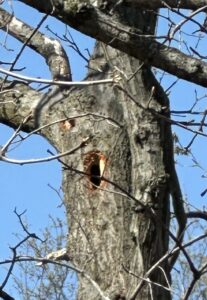 Cleon shot this video at our bird feeders. You can see the juvenile is as large as she is – stocky and well-fed! She is feeding him peanuts – these Downies all love peanuts! This juvenile came from the nest in a tree that is at the edge of our lake – here it is. We watched both the male and the female excavate this hole. We were a bit surprised because in our experience, Downy Woodpeckers’ holes are generally more round and this is definitely more of an oval. Regardless, they excavated it and this juvenile was born in it.
Cleon shot this video at our bird feeders. You can see the juvenile is as large as she is – stocky and well-fed! She is feeding him peanuts – these Downies all love peanuts! This juvenile came from the nest in a tree that is at the edge of our lake – here it is. We watched both the male and the female excavate this hole. We were a bit surprised because in our experience, Downy Woodpeckers’ holes are generally more round and this is definitely more of an oval. Regardless, they excavated it and this juvenile was born in it.
Video 6/25: Cedar Bog Nature Preserve
I shot this video from the boardwalk trail through Cedar Bog Nature Preserve. And note this is not actually a bog, but a fen. For more on this, read my blog from 6/25. This is a 2 minute video of gazing over a sedge meadow You will hear lots of birds singing: Red-winged Blackbirds, American Goldfinches, Northern Cardinals, American Robins, and Carolina Wrens. But the 3 that dominate this video are Common Yellowthroats, Song Sparrows, and Eastern Townees. And all this simply blends together! It was a very hot and humid afternoon at this nature preserve and although we spent about 2 hours on the boardwalk trail just taking everything in, when we got back to our car, we immediately took the Eastern Towhees’ advice. We drove to a restaurant and drank lots of tea – in our case iced tea!!!
Video 6/25: Gallagher Fen State Preserve – Springfield, OH
The Wood Thrushes and Red-eyed Vireos were with us and sang the entire time we were on this trail – 1 mile to the Pioneer Cemetery and 1 mile back. I cannot imagine being accompanied by anything lovelier! The Wood Thrushes dominate, but you can hear the Red-eyed Vireos from time to time. And 1 cardinal! Such a lovely walk through beautiful woods.
Video 6/25: A different male Mallard preening – part 2
In this and the previous video, it is the same male Mallard – but a different male Mallard than the one in Mallard Preening. All 3 videos were shot in the same place – Eastwood Park near Dayton, OH. Both males were part of a small group of Mallards who were all preening and resting. These Mallards were very used to people and cars. Notice in these 2 videos – parts 1 and 2 – all the motions this male goes through to preen. Together, these 2 videos add up to a bit less than 4 minutes. This Mallard was preening before I began shooting and he was not finished when I stopped, so the preening process is not only important to all birds, but does take a long time. And notice how he frequently rubs his bill into the upper base of his tail. That is where his oil gland is and this gland secretes oil which he rubs on his bill and then rubs it all over his feathers which keeps them waterproof. Seems to me all that rubbing, rearranging, and pulling of feathers would feel good. And it had a psychological effect on me. After watching all this for some minutes, I could not help but think how good a hot shower was going to feel when I got back to our hotel room!
Video 6/25: A different male Mallard preening – part 1
Video 6/25: Mallard Preening
I took this video of a male and female Mallard preening at Eastwood Park near Dayton, OH. If you watch the male, you will see the lovely feathers of the underside of his wing.
Video 6/25: Woodman Fen 2
Turn up your volume. The bird who is singing through most of this 2 minute video is a Gray Catbird and his song is full of mimicked sounds and buzzes. If you listen closely, you can hear the phrases and the repeats. He – and I say ‘he’ because although the female does sing, it is the male who is the robust and lengthy singer – and this bird was both. He began long before I started this video and brought his song to an end just before I stopped the video. I write at length about the songs of the Gray Catbird and its cousins the Brown Thrasher and the Northern Mockingbird in my ebook Common Songbirds and Raptors in You Yard, Neighborhood, and Favorite Park which is available from this website.
Video 6/25: Woodman Fen
Turn up the volume! Birds are singing everywhere in this lovely oasis that is a fen. You will hear background noise from the surrounding neighborhood – we are certainly the noisiest species on earth! But sit back, relax, and enjoy almost 2 minutes from the trail at Woodman Fen. Near Dayton, OH.
Video 6/25: Aullwood Audubon
Adjust your volume so the sound of the running water in the stream is soothing, then sit back and enjoy this lovely scene from the trail at Aullwood Audubon. Near Dayton, OH.
Video 6/25: Lots going on at the large birdbath!
Cleon took this video out our kitchen window. You will see a Brown Thrasher tossing the mulch around looking for something tasty. You will also see a female Baltimore Oriole at the feeder and a male Baltimore Oriole taking a bath. From now through about mid-August, there will be lots going on at this large birdbath and oriole feeder – watch on the live stream! Oriole juveniles should be appearing any day now – there was already a House Finch family. You could tell the juveniles as not only did they look like their mom, all 5 jammed themselves into the oriole feeder at the same time. You will never see adults of any species do that. These juveniles had probably just left the nest so they were most comfortable being right on top of each other. They did not eat anything – evidently they have yet to learn just how wonderful that grape jelly is. Mom and dad sure know!
Video 4/25: Gray Catbird has migrated back!
Cleon took this video out our kitchen window. The Gray Catbird is back – we hope to see a few more. For the past 3 years, we have had 2 pairs in our garden and both nest in our long shrub border which is along our driveway. This is the first one we have seen this year. And he came immediately to the big birdbath you see on the Birdbath Cam – I am saying ‘he’ because most often the males arrive first and the females several days to a week later. But this is a guess as males and females look alike. When he finished his short bath, he went to the Baltimore Oriole feeder and enjoyed some grape jelly. As the days and weeks go by, you should be able to see the catbirds fairly regularly at both this birdbath and that feeder – they love grape jelly as much as the orioles do! And the orioles and catbirds seem to be able to share the feeder without a lot of aggression and posturing – not too much fighting or jockeying for position. It probably helps that Cleon keeps the 2 cups in that feeder filled with grape jelly.
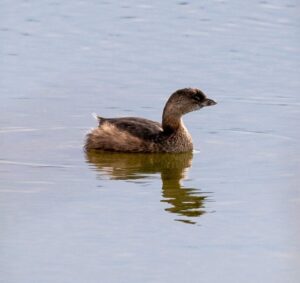
Video 4/25: Pied-billed Grebe
My husband Cleon shot this video of a lone Pied-billed Grebe in the inlet of our small lake. These grebes are fairly common here in central Illinois in migration this time of year and can be alone or in loose groups of 3 to about 7 or so. These are diving water fowl – remember grebes, cormorants, mergansers, and coots are not ducks. The ID traits I always look for when identifying this bird are first, the ring around its bill. Then its small size – about 12-13 inches from head to tail. And notice, no tail at all – just a nicely rounded, little rear end.
The sound on this video is decidedly odd – and is not on Cleon’s original video which he took with his phone. When I post a video, it goes through two steps – first it is ‘created’ on YouTube, and from there is is posted onto this website. And this went through a third step – he emailed it to me. Somewhere along the way a ghostly voice was added! It is not Cleon. It is not me. Cleon was alone inside the house when he shot it – it is through a window. He had no radio, TV, or computer on. So????? My advice is to watch with your volume turned off, but if you like a mystery, turn the volume on and if you have any ideas as to how this ‘soundtrack’ was added – use the Public Forum or email me at lindahendricksspence@birdingbeyondthefieldguide.com. I have no idea!
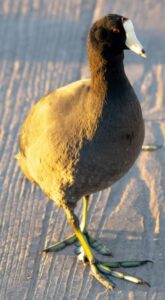
Video 4/25: American Coots
I shot this video on the large lake about 30 miles north of where we live. We are on the northern edge of where their migration ends and the southern edge where their nesting begins. Hundreds come through here each spring and can be found in large flocks on all 3 of our area’s large lakes – and then they disappear. Like the Hooded Merganser and Double-crested Cormorants in previous videos, these Coots are not ducks. But like ducks, they spend a lot of time on the water. Like Mergansers and Cormorants, they dive for food.
And check out those feet in the photo! Not the webbed feet of ducks, but great big chicken feet! Lobed toes. Regardless of the fact their feet are not webbed, Coots are excellent swimmers – both on the surface of the water and underwater.
At the end of this video, a male Mallard will swim by and you will be able to compare his size to the size of the Coots.
Video 4/25: Roadside Tree Cutting – Video 3
Janelle Cornell of Illinois sent this video to me after watching the 2 videos I posted called Roadside Tree Cutting. To see these previous videos, scroll down this list of videos. Both were posted in 2/25. This method of tree management just sickens me. There are alternatives to this type of tree cutting and pruning – probably more time consuming and more expensive, but does anyone really want a result that looks like this? Another row of full-grown trees – places for birds perch, rest, preen, forage, and nest – not just gone, but savagely butchered.
Video 4/25: Wild Turkey
I suggest turning your volume down low – road noise. Such a shame since this is such a bucolic scene. But we all know our world is filled with noise that we humans make and the sound on this video certainly confirms that. But what a majestic bird! And if you keep your volume low, you will hear quacking of Mallard ducks – over the road noise. This is the same pair that is seen with the female Hooded Merganser in the previous video.
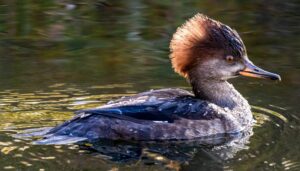
Video 4/25: Female Hooded Merganser
Like cormorants, grebes, and coots, mergansers are not ducks. However, like ducks, they are birds who spend almost all their time on water. Mergansers dive for their food – as you can see in this video. Interestingly, this female Hooded Merganser is with a pair of Mallards – she will always to be to the right of them in the video. If you compare their sizes, you will see both Mallards are much larger. It is hard to see in this video, but her crest – her hood – is a bit small and ragged. This could mean she is either molting or was born last year and is only now coming into her adult plumage. Cleon and I watched her for a long time and she never left those two Mallards. As we were leaving, all 3 were huddled together at the far shore of this flooded stream. Other than close proximity, we could see no communication amongst the 3 but they were obviously together and comfortable being together. It was a very peaceful scene.
I shot this video close to where I shot the previous video of the singing frogs. And you can hear the frogs in this one. But at least in this video, you can hear the birds. In the previous video, the frogs are so loud, all bird song and calls are drowned out. If you listen closely, you will hear American Robins singing and giving their alarm calls, Red-bellied Woodpeckers calling and drumming, and Red-wing Blackbirds. I did not want to get closer to this merganser as they can be skittish and fly off if they sense any disturbance whatsoever. She was so comfortable with the Mallards and is obviously foraging – although with not nearly as much success as the cormorants in the previous video (the video before the singing frogs). I did not want her to know we were there so we kept our distance. We were no threat to her, but she would not know that.
Video 4/25: Relax…… and smile while listening to frogs!
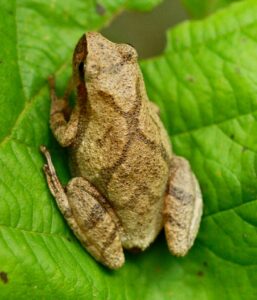
This is a photo of a Spring Peeper – one of the species in the group called Chorus Frogs. Cleon and I are from southeastern Pennsylvania and this tiny frog – dozens to hundreds of them – occupies places of shallow water and every spring bursts into ‘song’. Just a wonderful way to know spring is here! In my observations, they only ‘sing’ on sunny days and only when they think they are safe. If they sense your presence – either you walk too close or you try to get out of your car – they stop ‘singing’ immediately. All at once. And when they think it is safe, they all start up again – all at the same time. If any of you have ever sung in a group or chorus, you know beginning and ending all together at the exact same moment is not the easiest thing to do. This video was shot here in central Illinois and I believe what you will hear are also Spring Peepers. However, I am as far from being an expert on frogs as you can get so if any of you are, and these are not Spring Peepers, please use the Public Forum to tell us what they are. This photo of a Spring Peeper was taken by Ashlee Marie on Unsplash.
The area you see in this video is a flooded area – nearby is a nice-sized stream which has overflowed its banks as it does almost every spring. You will see more of this area in the video of the female Hooded Merganser.
Video 4/25: Double-crested Cormorants – just arrived!
Cleon took this video of a group of Double-crested Cormorants who are migrating and have just arrived on our small lake. They could rest here and continue north or they might stay here – not on our lake, but on one of the larger lakes close-by. And as you can see – there are fish in our lake!
Videos 4/25: Pileated Woodpecker 1
Pileated Woodpecker 2
Pileated Woodpecker 3
All 3 videos were shot by Hope Rupp through a window in the office building where she works near Harrisburg, PA. All 3 are of the same female Pileated Woodpecker who has been at this window each spring for the last 3 years. She does peck from time to time. Hope says her boss – whose office this is – is startled each time but also is glad the bird is saying hello. My guess is with that thick sturdy beak, she could take some BIG whacks! The first 2 videos show how alive this bird truly is – it is all in her eyes. And I can’t help but wonder – What is she seeing through that window? What is going through her mind? She is obviously observing and processing what she sees. She is there quite often so must feel safe? Why? What is it about that particular window on that particular side of the building that she continues to hang from that same spot day after day? In the third video, it was time for the bird to move on and to stop pecking. That is Hope’s finger you see gently signalling to the bird to move on and you will see the lovely black and white pattern of this bird as it moves its wings. The Pileated Woodpecker is a magnificent bird in every way!
Video 3/25: Turkey Vultures
What do Turkey Vultures do on a cold spring morning when the sky is overcast? Maybe we should take a page from their book – take time to look to the horizon. Be with your friends. Contemplate the meaning of life.
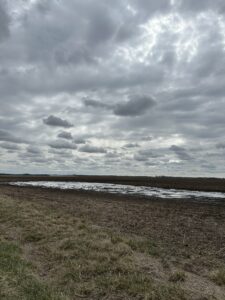
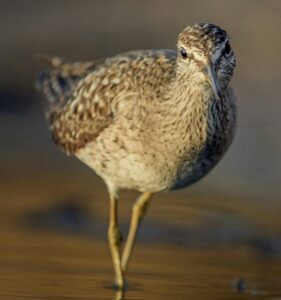
Video 3/25: Killdeer
This is the same wet spot where the Video: Sandhill Crane was shot – only 3 weeks later. Notice the field behind the wet spot looks a bit different. The farmer has worked the ground and it is now ready to plant. But also notice the farmer left the wet spot untouched. You can see by the photo to your left this is a huge field. It runs from the grassy berm at the bottom of the photo to the horizon. This wet spot would be less than 1% of the field so money earned by the farmer by plowing this wet spot would be negligible. Regardless, this farmer should be applauded because there are farmers who would have plowed it up – destroying it for this year. We have been there twice in 3 weeks – about 15 minutes each time We have seen Mallards, a pair of Green-winged Teals, a lone Sandhill Crane, over a dozen Killdeer, over a dozen Red-winged blackbirds, several Solitary Sandpipers, and a Short-billed Dowitcher. If we could have sat there all the daylight hours of the last 3 weeks, imagine what we would have seen!
The stars of this video are the Killdeer. You will hear them call, but watch them mirror each other in their movements. In Cleon’s and my opinion, their mirror movements – parallel to each other – are part of the mating ritual and also defining territories and borders. Regardless of the exact reason behind the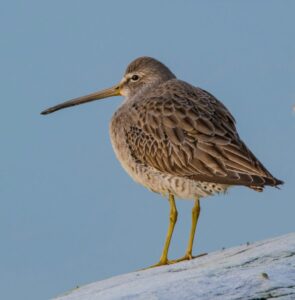 movements, these birds are very much in tune with each other. I have always thought Cleon and I are in tune with each other, but there is no way we could instinctively move across a room with our movements perfectly synchronized – not unless we took many, many dance lessons. We found this very interesting.
movements, these birds are very much in tune with each other. I have always thought Cleon and I are in tune with each other, but there is no way we could instinctively move across a room with our movements perfectly synchronized – not unless we took many, many dance lessons. We found this very interesting.
Towards the end of the video you will see 2 Solitary Sandpipers and 1 will take a bath. When the bath is over, a Short-billed Dowitcher will step into view. The second Solitary Sandpiper will take a bath – followed by the Short-billed Dowitcher. You can see, they have discovered a natural ‘bathtub’. Migrating must be dusty work! Remember, these birds still have a long way to go – both nest in central Canada. This is a longer video, so get comfortable, grab something soothing to drink, and enjoy!
Video 3/25: Northern Shovelers
Northern Shovelers! Just arrived on our small lake today – 3/12. I just wish they would stay longer, but we love seeing them for the 3-4 days they will be with us before moving on. You will be seeing 2 males and 1 female. Notice the bright white on the males which contrasts so beautifully with the darker, richer colors. She resembles a female Mallard. But one thing that always sets these ducks apart is their large bills. Notice that in proportion to their body and head size, the bills are long and look a bit heavy. Out of all the dabbling ducks their size, these shovellers have the largest bills. I recommend you turn the volume off as there are no bird – or duck – songs or calls, but there is some annoying background noise. With your volume turned off you can just enjoy the serenity of their effortless swimming.
Video 3/25: Sandhill Crane
Cleon and I were driving east from our house towards the Indiana state line. We come this way quite often. On this stretch of rural road are several low areas within good binocular range of the road and in spring, these low areas are flooded with several inches of water. These are havens for migrating sandpipers and plovers, and there are often Mallards. Today we had an uncommon sighting for us here in central Illinois – a Sandhill Crane. We were thrilled for us, but worried about it. These are birds that are almost always in flocks which can be small to very large. They are rarely/never alone. But this bird was. This is a good place for it to rest – water and plenty for it to eat. You will hear road noise, but it is some distance away so as long as the bird stays in the vicinity of this wet area, it will be safe from traffic. You will hear it call repeatedly – especially from the middle of the video to the end. There are no answers to its calls. This bird is truly alone. Where we were is on the very western edge of its migrating range. You will also hear Red-winged Blackbirds and Killdeer calling and the pair of ducks that appears during the second part of the video are male and female Green-winged Teals. Talk about us being at the right place at the right time!
Video 3/25: Snow Geese in a Harvested Corn Field 2
In this video, you will see groups of birds interacting with each other. What I find interesting – besides the fact they never shut up! – is it does not seem to matter if the bird is a white morph or a blue morph. You will see both morphs freely interacting with each other and from a human point of view, it generally seems like friendly interaction. One morph is not doimant over the other, but are all foraging and resting together. Geese can be aggressive towards each other and this would be easily seen on their nesting grounds on the tundra in northern Canada. But here in central Illinois, in migration, they are all working together for the same goal – to make the long trip safely and in a good time frame. I think there is a lesson there for us. There is a time for us to defend our homes, our families, our territories from interlopers and predators, but there is also a time when we should be able to put aggressions aside and cooperate with each other over shared goals
Video 3/25: Snow Geese in a Harvested Corn Field 1
This is quite a large flock of Snow Geese. However, as flock size goes for these geese, this is probably about average. They can be much larger than this. Notice you can see both color morphs – the white morph and the blue morph which does not look blue but dark. To actually see the blue shades, you need to view this morph through your binouclars or a scope. Turn your volume up as you will want to hear these birds – they are chatty. They communicate with each other as they are resting and foraging as they are here, when they are flying, when they are in water, and all might long. 24/7 when they are migrating. That is a whole lot to say!
Video 2/25: The Greater White-fronted Geese Have Landed!
This flock will stay here afour 3-4 days and then move on. they are migrating north to their nesting grounds which are on the tundra of northern Canada at the Arctic Ocean.
Video 2/25: Roadside Tree Cutting Video 2
This is a continuation of the previous video.
Video 2/25: Roadside Tree Cutting Video #1
I shot this video on the road we use every time we drive to town. Someone made the decision not only to trim these trees, but also as to the method used. And the irreparable damage is simply heartbreaking. More to follow in the next video.
Video 1/25: White-throated Sparrows and Juncos
You will see the brown and tan morphs of the White-throated Sparrow and male Juncos. These shrubs are deciduous azaleas – the ‘waiting room’ when the feeders get too crowded or for rest after eating a big meal. Underneath these shrubs is a thick layer of leaves and shredded bark mulch – White-throated Sparrows love this sort of ground cover. Turn up your volume and you will hear these birds softly calling to each other. And if you listen closely, you will hear the whistle of a Mourning Dove’s wings as it takes off from the feeders that are close-by. You will also here a male and female cardinal calling to each other. The muffled noise you will hear – which almost sounds like a dog barking from within a barrel full of water – is a Barred Owl from across the lake and deep within the vast riparian woodland. This owl and its mate called back and forth to each other from the time I shot the video – about 3:30PM – until dusk. And then they stopped. The Barred Owl is one of the few owls that can be active in daylight. These two were – and it is mating and nest building season for them.
Video 12/24: Relax and Breathe
Cape Hatteras National Seashore, NC. A quiet, rhythmic Atlantic Ocean on a beautiful day.
Video 12/24: Boat-tailed Grackles
This video was taken on the pier at Kure Beach, NC. It was late afternoon, a lovely sunny day, a light breeze, and with temperatures in the mid-fifties. The pier was full of people – walking, watching the waves, and fishing. And right with them was a flock of Boat-tailed Grackles. You will only find these grackles along the Atlantic or Gulf Coasts. They are larger than our more common Common Grackles. Notice the birds in this video have yellow eyes. Almost all Boat-tailed Grackles on the Atlantic Coast have yellow eyes and those on along the Gulf Coast have dark eyes. Interesting, don’t you think? And notice how different the females are – not black at all but a gorgeous shade of russet. Turn your volume up so you can hear their ‘song’.
Video 12/24: Relax and Breathe
In the town of Manteo, NC, is a lovely park along a waterway. There is a boardwalk. It was just so peaceful and serene – I wanted to share that with you.
Video 12/24: Bears!
Alligator River National Wildlife Refuge, eastern North Carolina. Do you think this is a mother and her cub from last winter? If you have an opinion or your own bear story to tell, please use the Public Forum to share with all of us.
Video 12/24: Brown Pelicans in Flight
I shot this video standing on the beach at Cape Hatteras National Seashore, on The Outer Banks, off the shore of North Carolina. I am looking out over the Atlantic Ocean. In my experience, pelicans often fly in a straight line or in a slanted line – with fairly even spacing between birds. In this, they resemble, squadrons of planes, squads of soldiers and marching bands – groups I normally do not associate with each other. The gulls you see flying in the background are Great Black-backed, Herring, and Laughing Gulls. There are 3 fishing boats out there attracting these gulls.
Video 12/24: Canada Geese on Our Lake
We have cold winters here in central Illinois, but January and February are our coldest months. Our lake is often frozen solid. We do have two intrepid ice fishermen who make me cold as I stand at the window inside my warm house watching them all bundled up and sitting on upturned buckets with their lines down the holes they drilled. Hi Mike and Andy! But as you can see in this video, our lake is starting to freeze now, and I just cannot imagine being a goose and not only swimming in that frigid water but curling up and sleeping on the ice. You probably know that there is now a new species of ‘Canada Goose’ which is not a Canada Goose – information from The National Audubon Society states this happened in 2004. This new species is called Cackling Goose and it was formed from 4 of the smaller subspecies of Canada Goose which showed enough differences from the other subspecies of Canada Goose that they were combined and then declared a separate species. And we do have them in the winter on our lake but I am not sure these are Cackling Geese. I have to use the scope and compare sizes of beaks, length of necks, and also some behavior. It is easiest for me if the two species are side by side. I took this video standing at the back door of our garage – my scope was inside the house and I was short on time. I will discuss this more in my blog as the winter proceeds and hopefully include some photos of both Canada Geese and Cackling Geese. You will easily see the similarities and I will try to show the differences. My guess is all the geese in this video are Canada Geese. If any of you disagree, please use the Public Forum and tell all of us why. If you want to research this further, a good place to begin is allaboutbirds.org. And look during the first few seconds of the video – Mallards!
Video 12/24: Relax and Breathe …..
Pamlico Sound, the Outer Banks. Sit, watch, relax, and just breathe …….
Video 12/24: Great Black-backed Gull in Flight
As we crossed The Virginia Dare Bridge from the mainland of North Carolina to Roanoke Island, dozens of these gulls were sitting on the railing. This is the largest and most dominant gull on the east coast. You will get an idea of the size of this gull in the video – most especially toward the end when you will see the big wingspan. And such strong, agile and graceful fliers. and watch the fishing boat – this gull is really moving!
Video 12/24: Look Who’s Back!
The American Crow is back at our birdbath and now what is it doing? Because this is a heated birdbath – we call it the birdy hot tub – Cleon took the rocks out for the winter so there is nothing for this crow to move around. Or so you might think …….
After standing at the window and watching, Cleon added some rocks back to the birdbath – this bird is a devoted re-arranger! So keep your eye on it – the crow should be back. And maybe bring its friend?
Video 12/24: Tundra Swans 2
More Tundra Swans at Alligator River NWR. Notice the five smaller, darker, swimming birds in the left center of the opening frames of this video. These are Greater White-fronted Geese – and getting along very well with all these swans. Turn up your volume and listen. The white swans are adults and the swans that are more gray or just look darker are juveniles.
Video 12/24: Tundra Swans 1
These hundreds of Tundra Swans started coming into The Alligator River National Wildlife Refuge about November 25th. Turn up your volume so you can hear them.
Video 12/24: WV Relax and Breathe
Wild, wonderful, West Virginia. I stood here to relax and wanted to share it with you. Just enjoy the snow and the water. The peaceful scene. Keep your volume low. And as is everywhere throughout the state, you do not have to travel far to be alone and with nature. This is .5 miles off I-64.
Video 11/24: American Crows Rearranging Rocks
A Crow and Crow Friend are busy at the birdbaths. The crows are more in silhouette since of course they would do this when the birdbaths are in full shade and I have lightened the video as much as I can. Even though the crows are dark you can still clearly see what they are doing. This is a 10 minute video, but watch it all if you have the time. The last minute or so is interesting – watch closely! And keep your volume turned up. In the middle, the crow will have its back turned toward the camera so you cannot see what he is doing, but you can hear the rocks being moved – and dropped. Sit back, relax, and enjoy! A Slice of Life as a Crow!
Video 10/24: Last Winter at the Feeders
I took this video in February 2024, and as you can see, there is a lot of action to look forward to this winter on our livestream. You’ll spot Mourning Doves, Eurasian Tree Sparrows, and feisty American Goldfinches.
Video 10/24: White Pelicans and Double-crested Cormorants in Migration
These American White Pelicans and Double-crested Cormorants spent their spring and summer in central Canada or northern U.S. states. They are now migrating to the southern U.S., Mexico, Central America’s coasts, or the Caribbean islands. Note: In this video, I mistakenly referred to the cormorant as a ‘diving duck.’ It is not a duck; I should have simply said ‘diver.’
Video 10/24: The Three Friends – American White Pelicans
These three American White Pelicans are having such a leisurely time in the water. And synchronized ……. I wonder if they are related?
Video 10/24: Ring-billed Gulls
This video replaces the one that was here. Same place but a much prettier day! And with a very different ending ……..
Video 10/24: Ring-billed Gulls – second video
A different view of this flock of gulls.
Video 10/24: Double-crested Cormorants
These cormorants are sitting in a shallow part of the lake enjoying the sunshine. It was a beautiful day!
Video 10/24: American White Pelicans
A bit longer video of these pelicans simply enjoying their afternoon floating ….. swimming ………. What must it be like to simply float and watch the trees move in the breeze and the clouds float across the sky ………….
Video 10/24: American White Pelicans 2
Sometimes the world of birds fills me with awe – and this is one of those times. A quiet wow ………

